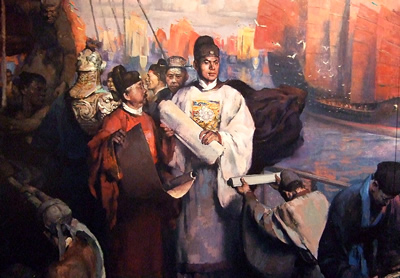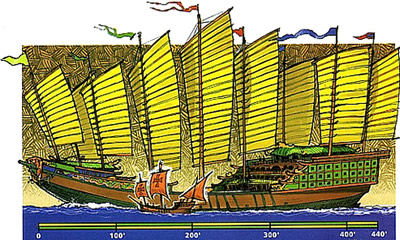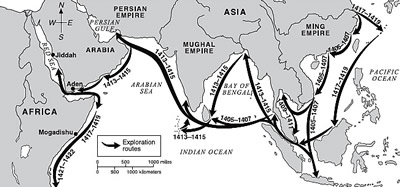World History
Zheng He was born into a Muslim family named Ma in Kunying, Yunnan province. At the beginning of the Ming dynasty (1368–1644), a number of generals fighting on the frontiers were put in charge of recruiting eunuchs for the court. When Yunnan was pacified in 1381, Zheng He, then aged around 10, was castrated and assigned to the retinue of Prince Zhu Di (Chi Ti) in Beijing (Peking).
As a young man, Zheng He accompanied Zhu Di and distinguished himself in a series of military campaigns against the Mongols. During the rebellion (1399–1402) by means of which the prince usurped the throne, Zheng He played an important role, culminating in the capture of the capital city Nanjing (Nanking).
Amid the conflagration, the dethroned emperor Zhu Yunwen (Chu Yun-wen) reportedly escaped. The suspicion that he might have been wandering abroad became one of the reasons Zhu Di, now Emperor Yongle (Yung-lo), launched a number of maritime expeditions led by his trusted eunuch, who was given the surname Zheng in 1404.
Preparations for the first voyage included the construction of oceangoing vessels of various sizes and the recruitment and training of the crew and staff of specialists. In 1405 more than 300 vessels and a crew of 27,800 men set out from the lower Yangzi (Yangtze) estuary and headed south along the coastal waters of Southeast Asia. After pacifying the troubled waters of the Malacca Strait, the fleet crossed the Indian Ocean and reached the port of Calicut on the Malabar coast of southern India.
The second expedition (1407–09) followed the same route as the first, adding visits to several states along the coasts of Vietnam, Thailand, Java, and the nearby islands as well as Ceylon (Sri Lanka). The third expedition (1409–11) explored the Ryukyu Islands, Taiwan, the Sulu Archipelago, and Borneo before reaching the same destinations as the previous voyage.
The fourth voyage (1413–15) expanded its reach to include the Maldives, Hormuz, the Hadramaut coast, and Aden. During the fifth voyage (1417–19), Mogadishu, Brawa, and Malindi in East Africa were added to the itinerary, and many rare species of plants and animals were brought back to the capital Beijing. The sixth voyage (1421–22) ventured south along the East African coast with visits to Zanzibar and probably Kilwa, located below the equator.
In 1424 Emperor Yongle died and criticism of the expensive voyages grew louder in the court. However, the new emperor, Xuande (Hsuan-te), wanted to launch yet another expedition in order to revive China’s tributary relations with the many states established heretofore. After many delays, Zheng He departed on his seventh and last voyage in 1431. His death in Calicut in 1434 ended the whole enterprise.
During a period of 28 years, China displayed a remarkably advanced maritime technology, which led to increased contact with scores of states and regions from the Malay Archipelago in the east to East Africa in the west.
Besides establishing diplomatic relations through the exchange of gifts and visits by foreign rulers to the Chinese capital, more markets were opened up for Chinese products, especially silks and porcelains. A brilliant commander, diplomat, and explorer, Zheng He made voyages that broadened China’s geographical horizons, and the maritime trade enriched its domestic economy during the heyday of the Ming dynasty
- East African City-states
East African City-states The Bantu migration from the central Sahara, perhaps the defining event in the history of Africa south of the Sahara, brought people to the region of East Africa as the nucleus of the emerging city-states. From the 10th century,...
- Ming Dynasty
Ming dynasty map The Ming dynasty, which spanned 1368–1644, can be divided into two segments. The first part, between 1368 and c. 1450, was a period of great achievement, growth, stability, and prosperity; the latter part, from c. 1450 to 1644,...
- Yongle (yung-lo) - Chinese Emperor
Yongle (Yung-lo) - Chinese EmperorThe man who became the third ruler of China’s Ming dynasty (1368–1644) as Emperor Yongle (Yung-lo) (meaning “lasting joyâ€) was the fourth son of Zhu Yuanzhang (Chu Yuan-chang), the dynastic founder....
- Southern Ming
Southern MingWhen a frontier people, the Manchus, took over control of China in 1644, Ming dynasty loyalists fled to southern China, where they held out for many years; they became known as the Southern Ming. Over several centuries, descendants of the...
- Voyages Of Discovery
Voyages of Discovery Since ancient times, mariners have traveled large distances, usually in search of opportunities for trade or military expansion. The Phoenicians are believed to have sailed from modern-day Lebanon to England for tin, and accounts...
World History
Zheng He (Cheng Ho) - Chinese Explorer
 |
| Zheng He (Cheng Ho) - Chinese Explorer |
Zheng He was born into a Muslim family named Ma in Kunying, Yunnan province. At the beginning of the Ming dynasty (1368–1644), a number of generals fighting on the frontiers were put in charge of recruiting eunuchs for the court. When Yunnan was pacified in 1381, Zheng He, then aged around 10, was castrated and assigned to the retinue of Prince Zhu Di (Chi Ti) in Beijing (Peking).
As a young man, Zheng He accompanied Zhu Di and distinguished himself in a series of military campaigns against the Mongols. During the rebellion (1399–1402) by means of which the prince usurped the throne, Zheng He played an important role, culminating in the capture of the capital city Nanjing (Nanking).
Amid the conflagration, the dethroned emperor Zhu Yunwen (Chu Yun-wen) reportedly escaped. The suspicion that he might have been wandering abroad became one of the reasons Zhu Di, now Emperor Yongle (Yung-lo), launched a number of maritime expeditions led by his trusted eunuch, who was given the surname Zheng in 1404.
  |   |
Preparations for the first voyage included the construction of oceangoing vessels of various sizes and the recruitment and training of the crew and staff of specialists. In 1405 more than 300 vessels and a crew of 27,800 men set out from the lower Yangzi (Yangtze) estuary and headed south along the coastal waters of Southeast Asia. After pacifying the troubled waters of the Malacca Strait, the fleet crossed the Indian Ocean and reached the port of Calicut on the Malabar coast of southern India.
The second expedition (1407–09) followed the same route as the first, adding visits to several states along the coasts of Vietnam, Thailand, Java, and the nearby islands as well as Ceylon (Sri Lanka). The third expedition (1409–11) explored the Ryukyu Islands, Taiwan, the Sulu Archipelago, and Borneo before reaching the same destinations as the previous voyage.
 |
| chinese oceangoing vessels |
The fourth voyage (1413–15) expanded its reach to include the Maldives, Hormuz, the Hadramaut coast, and Aden. During the fifth voyage (1417–19), Mogadishu, Brawa, and Malindi in East Africa were added to the itinerary, and many rare species of plants and animals were brought back to the capital Beijing. The sixth voyage (1421–22) ventured south along the East African coast with visits to Zanzibar and probably Kilwa, located below the equator.
In 1424 Emperor Yongle died and criticism of the expensive voyages grew louder in the court. However, the new emperor, Xuande (Hsuan-te), wanted to launch yet another expedition in order to revive China’s tributary relations with the many states established heretofore. After many delays, Zheng He departed on his seventh and last voyage in 1431. His death in Calicut in 1434 ended the whole enterprise.
During a period of 28 years, China displayed a remarkably advanced maritime technology, which led to increased contact with scores of states and regions from the Malay Archipelago in the east to East Africa in the west.
 |
| Voyages of Zheng-He |
Besides establishing diplomatic relations through the exchange of gifts and visits by foreign rulers to the Chinese capital, more markets were opened up for Chinese products, especially silks and porcelains. A brilliant commander, diplomat, and explorer, Zheng He made voyages that broadened China’s geographical horizons, and the maritime trade enriched its domestic economy during the heyday of the Ming dynasty
- East African City-states
East African City-states The Bantu migration from the central Sahara, perhaps the defining event in the history of Africa south of the Sahara, brought people to the region of East Africa as the nucleus of the emerging city-states. From the 10th century,...
- Ming Dynasty
Ming dynasty map The Ming dynasty, which spanned 1368–1644, can be divided into two segments. The first part, between 1368 and c. 1450, was a period of great achievement, growth, stability, and prosperity; the latter part, from c. 1450 to 1644,...
- Yongle (yung-lo) - Chinese Emperor
Yongle (Yung-lo) - Chinese EmperorThe man who became the third ruler of China’s Ming dynasty (1368–1644) as Emperor Yongle (Yung-lo) (meaning “lasting joyâ€) was the fourth son of Zhu Yuanzhang (Chu Yuan-chang), the dynastic founder....
- Southern Ming
Southern MingWhen a frontier people, the Manchus, took over control of China in 1644, Ming dynasty loyalists fled to southern China, where they held out for many years; they became known as the Southern Ming. Over several centuries, descendants of the...
- Voyages Of Discovery
Voyages of Discovery Since ancient times, mariners have traveled large distances, usually in search of opportunities for trade or military expansion. The Phoenicians are believed to have sailed from modern-day Lebanon to England for tin, and accounts...
